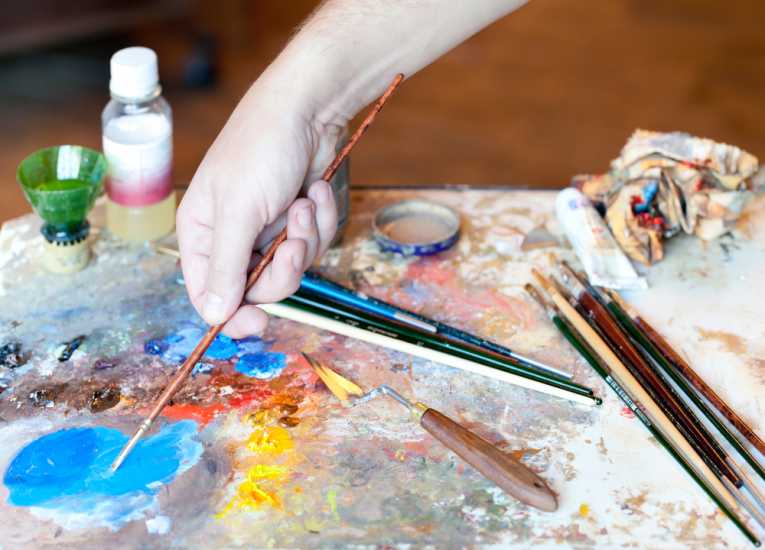Does your knowledge of the environment or engineering influence your opinion of art? Just as we are all becoming more aware of the environmental impact of our purchase power - some more aware than others of course - are you feeling increasingly aware of the environmental impact of art, design or film that you encounter? I've noticed that when I view art, particularly in a gallery with time and space for reflection, that I have begun to examine the environmental credentials of the artist and the potential environmental impact of their art"> potential environmental impact of their art.
For some time now it has been in vogue to make enviro-political statements through art, particularly installation art and modern sculpture. Memorable examples of enviro-political art include the artist that poured away thousands of gallons of water to highlight water shortages or the collages made from exotic bird feathers to highlight extinction issues and endangered birds.
One can see these examples from two juxtaposing positions; on the one hand you may have sympathy with the cause at hand, yet on the other you may feel that any waste is wasteful and that the art was unnecessary and ineffective. You could debate the merits of this till the cows come home (or soya burgers depending on your preference) and never be certain as to whether the increased environmental awareness outweighed the environmental impact of the materials used.
What of those artists that function outside this paradigm? Those not seeking to make a political statement about the environment, perhaps those making a different statement about a different issue or an artist making art with no political or moral statement, but simply to inspire thought and creativity? What about art that is simply meant to be interesting, look good or entertain you as you wander around gallery 7 in your lunch hour? When we see both government and the private sector incorporating environmental impact assessments into every department, and many people will have to consider their own working practices, then do artists need to provide information on the source of their materials? Or do they cross their fingers and hope that no one will care that they used ground copper, silver, gold and pearls to make their paint sparkle or that they're using products tested on animals, or parts of animals in their art?
Is this wasteful or immoral as these products can be used in medicine or another 'more deserving' pursuit? Is it wasteful if it makes decent art? On a recent gallery trip I found myself pondering whether we'd prefer to choose brilliant art using any materials the artist wanted and 'good' or 'ok' art made using reclaimed and recycled materials. Indeed, would it be morally right to restrict artists to only environmentally friendly products if it meant that fewer people would be inspired to invent and create their own work? Die-hard environmentalists may say 'yes, restrict the materials' however what if that artist would have created work about nature that inspired a gifted teenager to work in ecology or engineering and they in turn invented a new food system for cities based on a concept they'd seen in a painting? Is it possible that it's worth wasting a small amount of materials to keep our society creative and inventive?
These musings came to me as I wandered around an exhibit at a local gallery in Rochdale, England. Whilst examining the Nora Fok jewellery on display I was helping my daughter de-construct the pieces so that she may try to make some using a similar technique. In short, Nora Fok uses knitting, crocheting, weaving and knotting to create jewellery using modern manufactured materials such as nylon, steel infused bronze, cast silver, fused plastic powder, PVC rods and acid dyes. She also used plant and animal products such as seed pods, pearls, liquid amber seed pods, feathers, and many more, but it is nylon that dominates the room. Indeed the exhibit is called 'Cloud Nylon'.
Not for a minute do I suggest that there is anything immoral about this exhibit, it was her imagery of nature that started me on the road of wondering what products she uses to create these 'natural' shapes and figures. The exhibit is incredibly modern, utilising 3D printing and manufacturing techniques to create a variety of colours and an unusual combination of traditional crafts and plastic materials.
The skills she promotes are transnational, educational, traditional and worth preserving; furthermore she embraces mathematics, science, technology and different cultural traditions and in a sense displays all that is commendable about international artists. Her exhibit includes the technology used as part of the display, explaining the skills of the other people involved in producing her art and treats technology and engineering as admirable equals rather than with the disdain we see from many artists.
However I was pleased and intrigued to see that one of her earlier pieces had been made using the foam from recycled flipflops and that this piece was nearly - but not quite - as beautiful as her pieces made using new materials. The nylon pieces were clearly the best and used fishing wire as a material to knit and weave into jewellery and sculptures reflecting the beauty of plants; I left wondering whether the art would have been more or less pleasing had the fishing wire been reclaimed from nets and old rods, I for one would have enjoyed the pieces more knowing that there had been the creative re-use of real fishing wire that had previously been handled by another skilled craftsperson.
Please follow us on Twitter @earthtimes or via Facebook.










